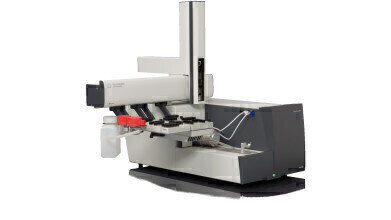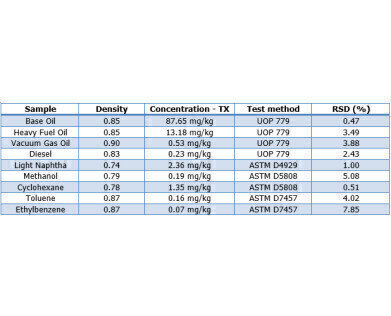-

-
 Image B: Table 1
Image B: Table 1
Measurement and Testing
Total Chloride Analysis - The Absolute Reference Method
Sep 17 2019
For decades, the presence of organic bonded chloride has been a relevant parameter for refinery and petrochemical processes. Challenges in recent years have been the increasing need of a matrix independent refence method and an ever decreasing detection limit. Why is chloride such an important parameter and which benefits does Oxidative Combustion Microcoulometry offer?
The Importance of Monitoring Organic Chloride Content
Refineries convert crude oil into all kinds of petroleum products. The presence of chloride in crude oil can lead to catalyst poisoning, which has a negative impact on the profitability of the refinery unit. Chlorides in the refining process are difficult to control, especially the organic chlorides. They cause various forms of corrosion at different temperatures and pressure levels, downstream of the distillation unit. Besides the corrosive effects, chloride also deteriorates the quality of the final product. Petrochemical facilities can transform refinery intermediates such as gas and liquid hydrocarbons into a wider range of petrochemical products. Feedstocks used to produce these chemicals (e.g. LPG, naphtha, and gasoil) often come from refineries. The presence of organic chloride in these feedstocks also promotes the risk of corrosion in the chemical production process. Maximum chloride levels are often specified for process streams and hydrocarbon products such as aromatic hydrocarbons.
How to Detect (Organic) Chloride Content?
Several international test methods focus on the analysis of (organic) chloride, often expressed as Total Chloride (TX), in crude oil, petroleum distillates, intermediates and aromatic hydrocarbons. Oxidative Combustion Microcoulometry is the benchmark technique to which popular test methods such as the ASTM D4929, ASTM D5808, ASTM D7457, and UOP 779 refer. Table 1* demonstrates the capabilities of TE Instruments’ XPLORER-TX while analyzing samples according to these international test methods. *(Please refer to image B for table 1)
Oxidative Combustion Microcoulometry – The Absolute Reference Method
Recently, XRF related techniques present themselves as alternatives to analyze chloride in petroleum products. When compared, microcoulometric detection technique has numerous benefits:
- Microcoulometry is an absolute detection technique. All (organic) chloride components are converted to hydrochloric acid (HCl). The XPLORER-TX achieves a 100% recovery. Therefore, calibration of the XPLORER-TX can be done, but is not even necessary.
- Microcoulometric titration can be applied to a much wider range of sample types, including liquids, solids, gas and LPG.
- Microcoulometry is not affected by the matrix and inhomogeneity of the sample. This can be seen as a major issue for XRF technique.
- Sulfur is another harmful component which is commonly present in petroleum products. Microcoulometry does not experience interferences of sulfur to the chloride signal. No sulfur analysis or dilution is required prior to chloride analysis.
- The measuring range of the XPLORER-TX (0.025 mg/L – 1000 mg/L), makes it the most versatile analyser for the analysis of chloride. Measuring samples in the sub-ppm range is impossible for most XRF techniques.
- At ppb level, the performance of the XPLORER-TX is unrivaled within the industry.
Digital Edition
PIN 25.1 Feb/March
March 2024
In This Edition Safety - The technology behind the ION Science Tiger XT - Safety with ammonia and LOHCs as hydrogen carriers Analytical Instrumentation - Discussion on new tribology te...
View all digital editions
Events
Apr 28 2024 Montreal, Quebec, Canada
Apr 30 2024 Birmingham, UK
May 03 2024 Seoul, South Korea
May 05 2024 Seville, Spain
May 06 2024 Riyadh, Saudi Arabia

















